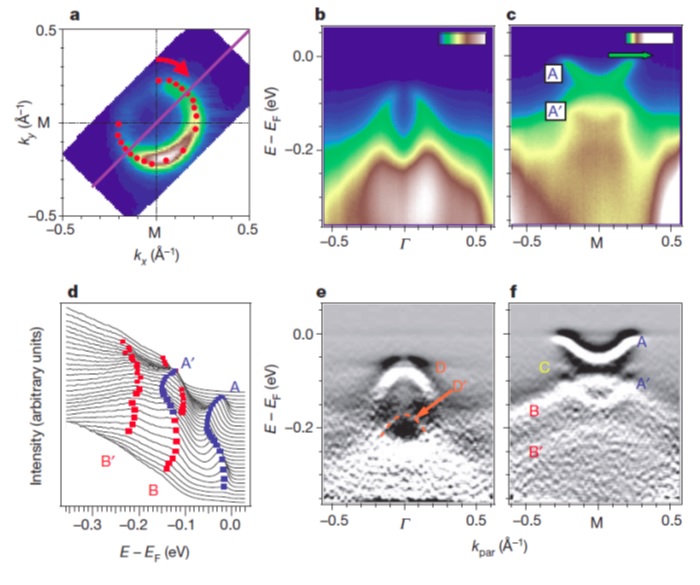In the past several years, multiple studies have confirmed superconductivity in single-unit-cell-thick films of iron selenide (1UC FeSe) grown on strontium titanate (STO), with gap opening temperatures approaching the boiling point of liquid nitrogen, which is nearly a decade higher than the superconducting transition temperature Tc in bulk systems(~8 K). Such an unusual enhancement not only sets a record Tc for iron-based superconductors, but also points to an important pathway to boost the Tc.
In a recent paper published in Nature, scientists from Stanford University and from Stanford Institute for Materials and Energy Sciences (SIMES) were able to grow 1 UC FeSe on STO using molecular beam epitaxy (MBE) and studied their electronic structure using the angle-resolved photoemission spectroscopy (ARPES) facility at SSRL Beam Line 5-4. Throughout the thin film growth and measurement process, the samples were kept under ultra-high vacuum conditions, an effective in-situ study.
ARPES is a tool capable of providing critical information about the momentum and energy of electrons in a solid. The measured band structure, the energy gap, as well as the associated superconducting transition temperature determined by the gap closing temperature agree well with previous studies (see Fig. 1). Intriguingly, researchers discovered an unusual spectral signature: replicas of the electronic band structure, displaced in energy by approximately 100 meV. Such a replica reveals a signature of electrons coupling to a boson, i.e., a collective excitation in the system, with boson energy given by the magnitude of the shift. For 100 meV, such boson is likely from the phonon in the STO.

Figure 1. Band structure of 1 UC FeSe film on STO. a, The Fermisurface, consisting of only pockets near the M-point. b-c, The measured dispersion along the high symmetry cut near the zone center and zone corner, with clear view of replica bands at the M-point. Bands and their respective replicas are marked with letters and primes. At the Γ point there is only a hole band which is 80 meV away from the Fermi energy. d, Raw data near the M point, and e-f, Second derivative plots of the data shown in panel b-c, highlighting the replica bands in both zone center and zone corner.
More importantly, the fact that the replicas are extremely sharp means that the excitation or absorption of a phonon has a minimal effect on the momentum of the electron. This is known as small-momentum, or small-q scattering. This type of electron-phonon coupling is unusual in that it has the ability to enhance Tc for many different types of gap symmetries.
In the work, scientists took a model for the Hamiltonian to propose a physically relevant gap structure. With this gap structure, they found that indeed small-q scattering was able to enhance the superconducting transition temperature. They were able to theoretically replicate the ARPES spectra, and calculated an effective increase in superconducting Tc of 50% (see Fig. 2). Such an enhancement is consistent when compared with the approximately 30 K iron-based superconductors with similar band structures.

Figure 2. Extracting the electron-phonon coupling. a, A high statistics scan around the M point at lowest temperature. The red rectangle indicates the region which is integrated over momentum to create an energy distribution curve (EDC). b, Background subtracted EDC of both data and simulation, which shows the relative peak intensities between the main bands and the replica bands. From the relative intensities one can extract magnitudes of the electron-phonon coupling. c, Simulated band structure that gives a similar dispersion and peak intensities. A veff of 10 meV is derived for the electron-phonon coupling. d, Tc enhancements as a function of different ratios of magnetic exchange values, where the total magnitude of J=30 meV is fixed from experiment. In this case, with veff/J around 0.3, one obtains an enhancement factor of 1.5.
This work provides a novel pathway whereupon one can engineer materials to have higher superconducting transition temperatures. Furthermore, such a mechanism for enhancement may provide insight into the general phenomenon of high-Tc superconductivity.
J. J. Lee, F. T. Schmitt, R. G. Moore, S. Johnston, Y.-T. Cui, W. Li, M. Yi, Z. K. Liu, M. Hashimoto, Y. Zhang, D. H. Lu, T. P. Devereaux, D.-H. Lee and Z.-X. Shen, "Interfacial Mode Coupling as the Origin of the Enhancement of Tc in FeSe Films on SrTiO3", Nature 515, 245 (2014), DOI: 10.1038/nature13894.




